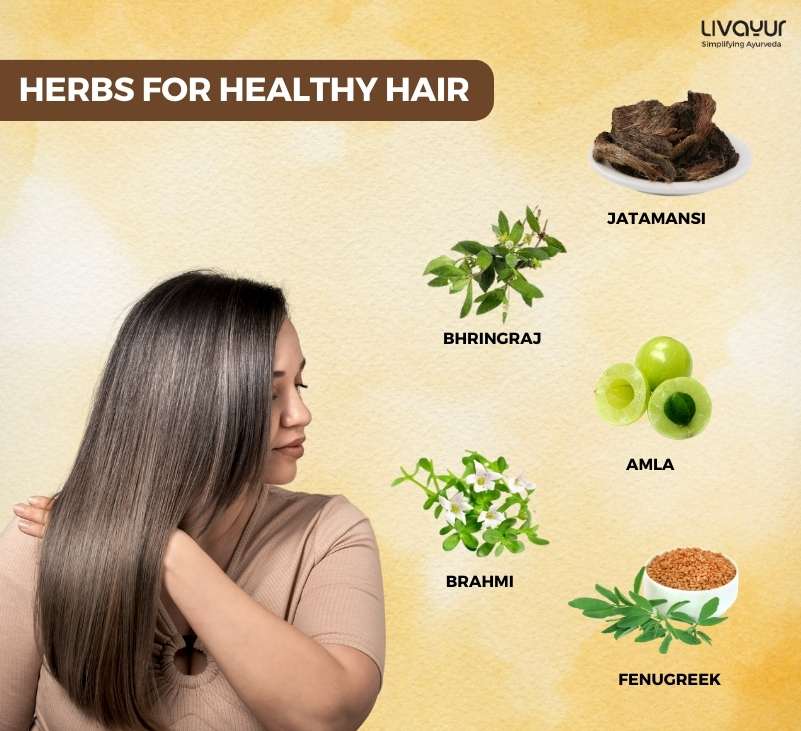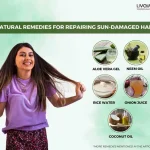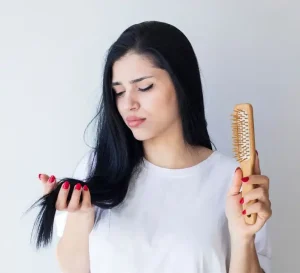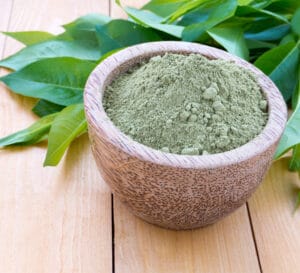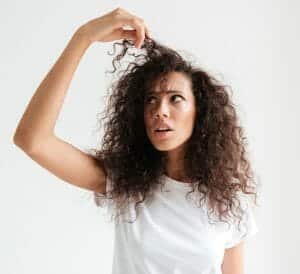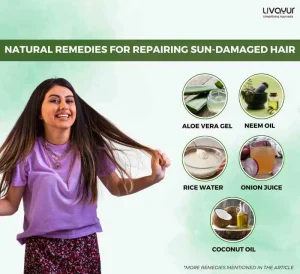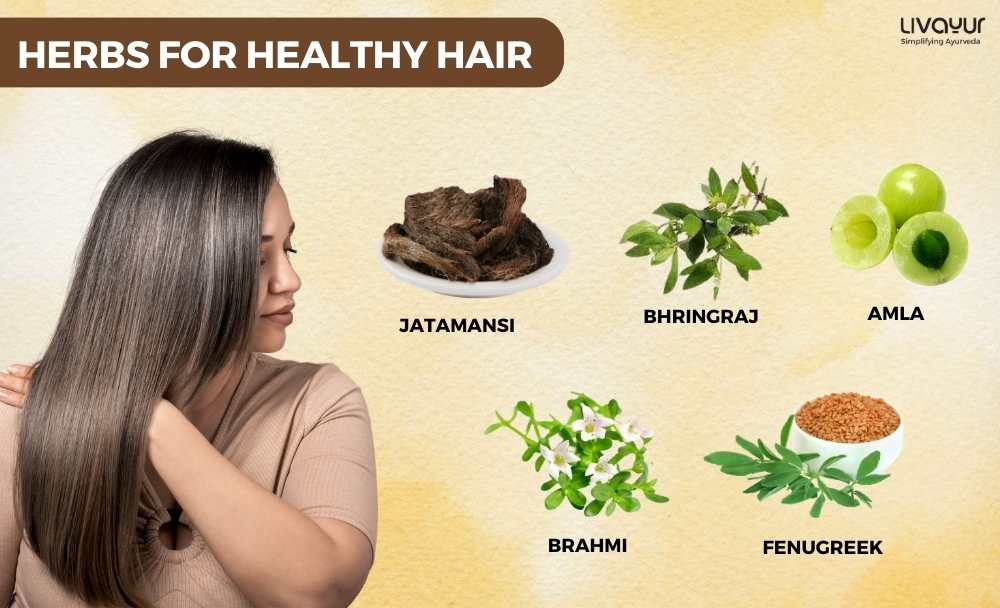
Almost everyone is suffering from hair problems, especially hair loss. Primarily caused due to poor dietary and lifestyle habits, it is one of the major concerns in the world.
Are you also looking for natural means to promote hair growth and boost your hair health? If yes, then here are some time-tested Ayurvedic herbs that can help prevent hair fall, strengthen your hair roots, and increase hair growth.
10 Best Ayurvedic Herbs for Hair Growth
1. Bhringraj (Eclipta alba) [1] [2]
Bhringraj is one of the best Ayurvedic herbs for hair growth. It is rich in vitamin E, calcium, magnesium, and iron, all of which help prevent hair loss. Furthermore, Bhringraj is also known to improve sleep and blood circulation levels in the scalp, further aiding in hair growth.
Nutrients in Bhringraj
| Vitamin D |
| Vitamin E |
| Iron |
| Calcium |
| Magnesium |
| Polyacetylenes |
| Flavonoids |
| Coumestans |
| Alkaloids |
How To Use Bhringraj?
- You can use Bhringraj in the form of oil.
- Simply, take some oil in your palm and massage it on your head using your fingertips.
- Let the oil soak for at least 1 hour.
Possible Side Effects of Bhringraj
- If taken orally Bhringraj may give you chills. Therefore, before taking the herb orally you must first consult a medical professional.
- If the herb doesn’t suit your skin, it may cause an allergic reaction with signs such as itching, stinging, swelling, or redness.
2. Brahmi (Bacopa monnieri) [3]
Another highly beneficial Ayurvedic herb for your hair is Brahmi. It helps strengthen the blood vessels, activate protein cells, and alleviate stress and anxiety.
Nutrients in Brahmi
| Coumestan derivatives |
| Triterpene saponins |
| Steroidal saponins |
| Triterpenes |
| Steroids |
| Steroidal alkaloids |
| Flavonoids |
| Phenolic acids |
| Thiophene derivatives |
How To Use Brahmi?
Brahmi can also be used in the form of oil. Massaging your scalp and hair strands with Brahmi oil can help prevent hair fall significantly.
Possible Side Effects of Brahmi
Some commonly reported side effects of Brahmi are:
- Itchiness
- Irritation
- Dry Skin
Experts advise you to try a patch test first and monitor if your skin has any allergic reaction to it.
3. Amla (Phyllanthus emblica Linn) [4]
Amla is an excellent Ayurvedic herb to enhance your hair health. Imbued with iron and antioxidants, it helps boost blood circulation in the scalp and promote hair growth.
Nutrients in Amla
| Fiber |
| Protein |
| Iron |
| Calcium |
| Phosphorus |
| Fat |
| Ascorbic Acid |
| Vitamin A |
| Vitamin B1 |
| Vitamin E |
How To Use Amla?
You can either use Amla in the form of oil or drink Amla juice every morning to avail its benefits.
Possible Side Effects of Amla
There have been reported cases of allergies resulting in hives and irritation, but allergies are subjective, so performing a patch test can help you determine how your skin will react.
It is advisable to consult a doctor if you’re pregnant before consuming amla at all or in excess.
4. Jatamansi (Nardostachys jatamansi) [5]
With potent anti-inflammatory and antimicrobial properties, Jatamansi is considered an effective Ayurvedic herb to prevent hair fall and improve your overall hair health.
Nutrients in Jatamansi
| Alpha-patchoulenese |
| Angelicin |
| Beta-eudesemol |
| Beta-patchoulenese |
| Beta-sitosterol |
| Calarene |
| Calarenol |
| Elemol |
| Resins |
| Sugar |
| Starch |
| Gum |
| Ketone |
| Sesquiterpin ketone |
How To Use Jatamansi?
Jatamansi is best used as oil. Jatamansi oil penetrates deep inside your hair follicles and strengthens your hair roots.
Possible Side Effects of Jatamansi
- People with high blood pressure must be extra careful when using Jatamansi (orally)
- Jatamansi is known to increase menstrual flow, so it should be avoided during already-heavy menstruation.
- It may cause vomiting and twitching abdominal pain (when taken orally) if used in excess.
- When using it as an oil – it is beneficial to perform a patch test and wait for at least 30 mins to check if your skin has any allergic reactions to it.
5. Fenugreek or Methi (Trigonella foenum-graecum) [6]
Loaded with nutrients such as vitamin A, vitamin K, vitamin C, and folic acid, fenugreek helps prevent hair fall and promote hair health.
Nutrients in Fenugreek
| Fiber |
| Phospholipids |
| Glycolipids |
| Oleic acid |
| Linolenic acid |
| Linoleic acid |
| Choline |
| Vitamin A |
| Vitamin B1 |
| Vitamin B2 |
| Vitamin C |
| Nicotinic acid |
| Niacin |
How To Use Fenugreek?
You can use fenugreek to make a hair mask. For this, soak 3 tablespoons of fenugreek seeds in 5 tablespoons of curd overnight. Then grind the mixture in the morning and apply the fenugreek paste on your hair roots. After 1 hour, wash your hair with lukewarm water.
Possible Side Effects of Fenugreek
Even though fenugreek is a natural herb, it might have certain negative consequences. Among them are a few of them:
- Headaches
- face edema and bloating
- Sighing
- Problems with digestion or gas formation
- Diarrhea
- Lightheadedness
- Congestion in the nose
- Coughing
- Severe allergic reactions in certain individuals who are more susceptible to allergies
In addition, a significant amount of fenugreek may cause a sharp decrease in blood sugar levels. Fenugreek, whether taken in excess or along with other herbs, may also be hazardous to your liver.
Fenugreek is also best avoided while pregnant. Besides small quantities of food, its use during pregnancy is not safe. Avoiding fenugreek during pregnancy is advised because it may increase the chance of birth defects.
6. Ashwagandha (Indian Winter Cherry or Indian Ginseng)
Packed with Vitamin C, Iron, and Calcium, ashwagandha strengthens hair follicles and fights free radicals promoting hair growth.
Nutrients in Ashwagandha
| Witanolides |
| Alkaloids |
| Flavonoids |
| Steroidal Saponins |
| Saponins |
| Coumarins |
| Sterols |
| Chlorogenic Acid |
| Resins |
| Lipids |
| Carbohydrates |
| Fatty Acids |
How to use Ashwagandha (Indian Winter Cherry)?
- You can use Ashwagandha oil – Massage it into the scalp
- You can also use Ashwagandha powder to shampoo your hair
Possible Side effects of Ashwagandha
It’s not quite clear if taking ashwagandha over an extended period of time is safe or not. However, the following are the most common ashwagandha side effects:
The less frequent adverse reactions are:
- Tiredness
- dizziness or vertigo
- congestion and cough
- Itching
- Hazy vision
- Mouth dryness
- Gaining weight
- Delusions
7. Shikakai (Acacia concinna)
Shikakai is an Ayurvedic herb high in vitamins A, C, D, E, and K. It fights dandruff, encourages hair growth, regulates hair loss, and gives dull hair bounce and gloss. Because of its high saponin concentration, shikakai is a common ingredient in shampoos and conditioners.
Nutrients in Shikakai
| Saponin |
| Alkaloid |
| Sugar |
| Tannin |
| Flavonoids |
| Anthraquinone glycoside |
| Vitamin A |
| Vitamin C |
| Vitamin D |
| Vitamin E |
| Vitamin K |
How to use Shikakai (Acacia concinna)?
- Boil 2 cups of water with 2-3 tbsp of shikakai powder in it, to make a semi-liquid paste.
- Pour in additional water and honey.
- Apply it to your hair
- Rinse with water
Possible Side Effects of Shikakai
Shikakai may be safe to eat, according to the majority of studies. On the other hand, using shikakai excessively can have some of the negative effects like:
- Respiratory issues including asthma (if used excessively)
- Oiliness on the scalp (if used excessively)
- Nausea, loose stool
- It may be dangerous to eat the leftover seeds that have been boiled in lukewarm water.
- Overuse can cause dry skin
- Bloating or uneasiness.
- Shikakai is said to be the cause of acidity.
Even Ayurvedic herbs could have particular adverse effects and respond differently in each individual. Make sure to speak with an Ayurvedic doctor before using it.
8. Hibiscus or China Rose (Hibiscus rosa-sinensis)
Hibiscus flowers, which are abundant in amino acids, help to bolster hair, delay the onset of graying, and promote hair development.
Nutrients in Hibiscus
| Carbohydrates |
| Calcium |
| Magnesium |
| Potassium |
| Vitamin C |
| B Vitamins |
| Anthocyanins |
| Flavonoids |
| Phenolic Acids |
| Organic Acids |
How to use Hibiscus?
Herbal extracts, like hibiscus, are usually combined with a carrier oil base in order to create herbal hair oils.
- Almond-based oil
- Coconut oil, jojoba oil, mineral oil, and olive oil
- Wheat germ oil and walnut oil
Herbal medicine practitioners typically advise you to:
- Massage the oil into your scalp for 10-15 minutes.
- Leave the oil to soak for about 30 minutes.
- Use a gentle shampoo to wash.
Possible Side Effects of Hibiscus
The plant hibiscus has been used for many years to care for hair, and it has recently been well-known as a home cure for stimulating hair growth. Although hibiscus is generally regarded as safe to apply topically to hair, some individuals may have negative effects. The following are hibiscus for hair growth negative effects that could occur:
- Reactions caused by allergies: Hibiscus can produce redness, irritation, and inflammation on the scalp in certain individuals.
- Skin irritation: If the skin is already sensitive, applying hibiscus directly to the scalp may irritate it.
- Hibiscus may cause dryness in hair, causing it to become brittle, damaged, and dry.
- Staining: Use caution when handling hibiscus flowers and leaves since they have the potential to stain your skin, clothing, and towels.
- Interaction with other hair products: Hibiscus may have an adverse influence on the efficacy of other hair products, including shampoos and conditioners.
Consult a physician or a hair care expert if you encounter any of these adverse effects or if you have any inquiries about utilizing hibiscus for hair growth.
9. Neem (Azadirachta indica)
Neem has been celebrated for its medicinal properties for centuries and is known as one of the most popular herbs for hair growth. Its antibacterial, antifungal, and anti-inflammatory characteristics make it a potent ingredient for scalp health. Using neem oil [9] or neem-infused products can aid in maintaining a healthy scalp by fighting infections, reducing dandruff, soothing irritation, and promoting hair regrowth. The richness of antioxidants and essential fatty acids in neem contributes to its ability to nourish the scalp and support overall hair health. It is a natural remedy that you may find beneficial in your regular hair care routines. [11]
Nutrients in Neem
| Crude Protein |
| Crude Fiber |
| Ether Extract |
| Ash |
| Nitrogen Free Extract |
| Gross Energy (Kcal/gm) |
How to use neem?
- Neem can be taken orally or applied topically to manage problems
- Applying neem oil topically can alleviate hair problem and neem oil massaging cam also effectively eliminate head lice.
Possible side effects of Neem
While neem offers numerous health benefits, particularly in topical applications, it is important to note that neem oil, when ingested, can indeed be toxic and potentially harmful, especially in large quantities.
- Neem oil contains compounds like azadirachtin and other limonoids, which can be toxic when ingested orally.
- Ingesting neem leaves or extracts regularly over a long period is also not advisable due to potential adverse effects on the liver and kidneys. However, the topical use of neem oil or products containing neem is generally considered safe for most people when used as directed. [10]
10. Aloe Vera
Aloe Vera is revered for its remarkable healing and calming qualities and is considered one of the best Ayurvedic herbs for hair growth. It plays a pivotal role in scalp care by harmonizing its pH levels, deeply hydrating hair strands, and fostering hair growth stimulation. By directly applying the fresh gel from the Aloe Vera plant or utilizing hair products infused with this miraculous ingredient, you can fortify hair follicles, fostering robust growth and nurturing the foundation for healthy, revitalized hair. [12]
Nutrients in Aloe Vera
| Vitamins |
| Enzymes |
| Minerals |
| Sugars |
| Anthraquinones |
| Fatty Acids |
| Hormones like auxins and gibberellins |
| Amino acids |
| salicylic acid |
| Lignin |
| Saponins |
How to use aloe vera?
Using fresh aloe vera gel for scalp care can indeed be beneficial.
- Cut a leaf from a live aloe vera plant and carefully extract the gel using a spoon. Some prefer blending it with coconut or olive oil for added benefits.
- Gently massage the gel or mixture directly onto the scalp, ensuring even coverage. Let it sit for about an hour.
- Wash your hair and scalp with a mild shampoo to remove the gel. Repeat this process 2-3 times a week or as needed.
- Before applying it to the scalp, try rubbing a small amount of aloe vera gel onto the wrist to check for any adverse reactions.
Aloe vera hair masks are another popular method:
- Mix aloe vera with substances like honey, jojoba oil, egg whites, or fenugreek. Massage this mixture into the scalp and hair, cover with a shower cap, and leave it on for 15 minutes to 1 hour before rinsing off with a mild shampoo.
- Commercial products containing aloe vera are also available for convenience and can be incorporated into your hair care routine.
Possible side effects of aloe vera
- Excessive consumption can lead to frequent stools and may cause dehydration.
- Some individuals might experience stomach cramping or irregular bowel movements.
- Irregular heartbeat or lowered potassium levels could occur in rare cases.
- Aloe may cause redness, burning, a stinging sensation and, rarely, dermatitis [13]
Avoid taking aloe vera internally if you have:
- Kidney Problems: Aloe vera might exacerbate existing kidney issues.
- Heart Disease: It may not be suitable for individuals with heart conditions.
- Diabetes: Aloe vera could affect blood sugar levels, so caution is advised.
- Pregnancy/Nursing: Safety during pregnancy and breastfeeding hasn’t been established, so it’s best avoided.
- Allergies: Those allergic to onions, garlic, or tulips might have a higher risk of allergic reactions to aloe vera. [12]
Some More Hair Growth Tips by Ayurveda [7] [8]
- Eat protein and iron-rich foods like beans, yogurt, raisins, dates, etc
- Avoid eating raw, cold, spicy, and sugary foods
- Wash your hair 2-3 times a week with mild or herbal shampoos
- Do not use extremely warm or cold water to wash your hair. It can reduce the strength of hair roots and cause hair fall
- Do not color your hair with chemicals
- Avoid using heat treatments like blow-drying, straightening or curling
- Practice Nasya, a therapy in which you administer Anu Tailam or Desi Ghee into your nostrils. It is known to nourish hair follicles and strengthen hair roots
- Practice yoga, pranayama, and meditation to relieve stress
FAQs
1. What nutrients in curry leaves support hair growth?
Curry leaves boast a rich content of Vitamin C, Vitamin B, proteins, and antioxidants. These elements collectively foster cellular regeneration, enhance blood circulation in the scalp’s blood vessels, and encourage hair growth. Their properties stimulate skin renewal, promote a healthy scalp, and contribute to overall hair health.
2. Are there natural ways to encourage hair regrowth within three weeks?
While regrowing hair naturally within three weeks might seem challenging, certain strategies can expedite the process. Consider incorporating a protein-rich diet, daily scalp massages, minimizing heat exposure to your hair, and ensuring proper hydration by drinking plenty of water. These practices can collectively contribute to promoting faster hair growth in a shorter time frame.
3. Which spices and herbs promote hair growth?
Rosemary: Often used as a seasoning, rosemary is known for its hair growth benefits.
Peppermint: Another herb that aids in promoting hair growth.
Aloe vera: Known for its soothing properties, aloe vera also contributes to healthier hair.
Black cumin: This spice holds properties that can support hair growth.
Cinnamon: Beyond its culinary uses, cinnamon is believed to have potential benefits for hair growth.
4. Which herb is beneficial for achieving silky hair?
Fenugreek, an aromatic herb, is renowned for enhancing hair health. It not only prevents hair fall but also stimulates hair growth. Packed with various bioactive components, fenugreek offers these beneficial properties. You can utilize fenugreek oil to achieve long and silky hair.
5. What fruits aid in faster hair growth?
Citrus fruits such as lemons, oranges, and grapefruits are abundant in vitamin C, essential for hair health. Berries are also rich in Vitamin C and collagen, beneficial for hair strength. These fruits notably enhance collagen production, improve scalp circulation, and shield hair follicles from oxidative damage caused by free radicals, thus promoting faster hair growth.
Conclusion
Using Ayurvedic herbs for hair growth like Bhringraj, Jatamasi, Amla, Brahmi, and fenugreek can strengthen your hair roots, nourish your hair follicles, prevent hair fall, and promote hair growth. In addition, Ayurveda also recommends making some lifestyle and dietary changes to boost your overall hair health. Using Ayurvedic herbs for hair growth is the best thing you could do to keep your hair healthy, shiny and voluminous for a long time. So, get ready to flaunt beautiful hair with the power of Ayurveda!
Disclaimer
This article is written from a health and wellness perspective and is not medical advice. Kindly seek the help of a certified medical practitioner before initiating any treatment.
References
- Eclipta alba :Hair Growth Promoting Drug in Ayurveda
- Hair growth promoting activity of Eclipta alba in male albino rats
- THE WONDER OF HERBS TO TREAT-ALOPECIA
- A REVIEW: HERBAL THERAPY USED IN HAIR LOSS
- Phytochemical investigation and hair growth studies on the rhizomes of Nardostachys jatamansi DC
- Fenugreek+micronutrients: Efficacy of a food supplement against hair loss
- Review article on ayurvedic aspect of Hairfall
- Khalitya (Hair Fall) Management – Ayurvedic Perspective
- Neem Oil: anherbal remedy for alopecia causes dermatitis
- Neem: A tree for solving global problems
- The power of neem in personal care formulas
- Aloe Vera
- Aloe Vera
- Eclipta prostrata (L.) L. (Asteraceae): Ethnomedicinal Uses, Chemical Constituents, and Biological Activities
- Functional and Nutraceutical Significance of Amla (Phyllanthus emblica L.): A Review
- Medicinal Properties of Nardostachys jatamansi (A Review)
- Fenugreek a multipurpose crop: Potentialities and improvements
- Ashwagandha (Withania somnifera)—Current Research on the Health-Promoting Activities: A Narrative Review
- A detailed investigation on shikakai (Acacia concinna Linn.) fruit
- Organic Acids from Roselle (Hibiscus sabdariffa L.)—A Brief Review of Its Pharmacological Effects
- EVALUATION OF THE NUTRITINAL VALUE OF NEEM (Azadirachta indica) LEAF MEAL ON THE PERFORMANCE OF FINISHER BROILERS
- ALOE VERA: A SHORT REVIEW




